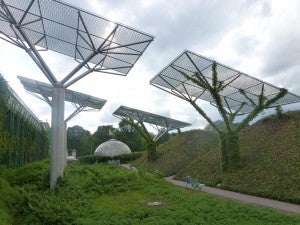Why Falling Oil Prices Don’t Hurt Demand for Renewable Energy
By: Victor A. Rojas, Senior Manager, Financial Policy, and Paul Stinson, Program Coordinator
 It’s understandable that many people would look at falling oil prices and wonder what it might mean for clean, renewable energy sources. Some recent headlines even suggest that cheaper crude might spell doom for the burgeoning clean energy economy.
It’s understandable that many people would look at falling oil prices and wonder what it might mean for clean, renewable energy sources. Some recent headlines even suggest that cheaper crude might spell doom for the burgeoning clean energy economy.
Over the last six months, the price of crude oil has fallen by about 40 percent, currently trading below $60 a barrel, the lowest it’s been since 2009. Continuing global production and oversupply mean oil prices could remain low through the winter months and well into 2015.
While it’s true that stocks for some of the more trusted, clean energy investments are being dragged down by dipping oil prices, it doesn’t mean demand for clean energy is also suffering. In fact, as oil prices have tumbled, demand for energy efficiency and renewable energy only keeps growing.
Oil can mean energy, but energy doesn’t mean oil
The historic correlation between the price of oil and the demand for renewable energy has been increasingly weakened in today’s global markets. Like apples and oranges, we use oil and renewables to make completely different types of juice: oil primarily to produce transportation fuels, and renewables primarily to generate electricity. From an economics perspective, oil and renewables are not substitutes: when the price of one decreases, demand for the other does not decrease.
But, if the falling price of oil doesn’t affect demand for renewables, why does it seem to weaken renewables stocks, even as solar power, for example, is growing faster than ever before? Simply put, it’s a problem of perception.
It is engrained in the public consciousness that the price of oil represents the price of energy in general. This correlation is a perceptual challenge with widespread financial and political repercussions. The mistaken logic that all energy is cheap because oil is cheap can create a disincentive for investors, policymakers, and customers to support renewables and energy efficiency.
Promise for a cleaner, more reliable energy future
If oil price volatility doesn’t mean reduced demand for renewables, then what, in fact, does it mean? According to Christiana Figueres, the UN’s climate chief, it means that investing in fossil fuels like oil is an increasingly risky strategy. At the recent UN climate talks in Lima, Peru, Figueres maintained that the instability of oil prices “is exactly one of the main reasons why we must move to renewable energy, which has a completely predictable cost of zero for fuel.”
What’s more, as noted in a market report from Bernstein Research last month, “Renewable energy is a technology. In the technology sector, costs always go down. Fossil fuels are extracted. In extractive industries, costs (almost) always go up.”
In other words, now is the time to be building the foundation for a stable energy future protected from the price volatility of fossil fuels. The good news is we’re well on our way. From solar, to wind, and energy storage, we’re reaching tipping points that promise further cost reductions and market acceptance for clean energy technologies.[Tweet “Now is the time to be building a stable, clean energy future protected from the price volatility of fossil fuels http://ow.ly/GP48z “]
It’s just as important to continue progress on the financial policy front. To that end, creative financing mechanisms, new asset classes, and public/private market solutions that facilitate capital engagement are making clean energy investing more accessible and more secure than ever. In the last year alone, demand for green bonds has soared from about $11 billion to more than $40 billion as more and more marquee banks, corporations, and multilateral organizations have entered the marketplace.
As the market embraces this new asset class, it’s crucial that we shift from proving green bonds’ efficacy to building out market infrastructure and developing meaningful standards for transparency, disclosure, and integrity.
Similarly, we need to advance the policies and tools that standardize markets for energy efficiency investments, which hold extraordinary potential for immediate energy and cost savings. Initiatives such as EDF’s Investor Confidence Project (ICP) bring together building owners, project developers, finance providers, and utilities to create a transparent market for trading in energy efficiency projects. In so doing, ICP lays the groundwork for securitization in the industry, which promises to catalyze project deal flow and unlock the vast potential of energy efficiency.
Advancing these and other financing tools is critical to the growth of the clean energy economy – and growing the clean energy economy is one of the best ways to correct the mindset that demand for renewables is linked to the price of oil. Ultimately, these efforts help put our country on the path toward a stable energy future unfettered by the need for subsidies and unhindered by the volatility of fossil fuels – and that’s a headline we’d like to read.










